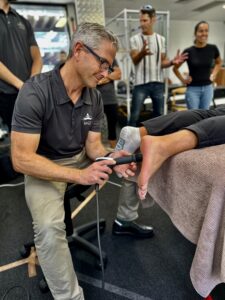When dealing with chronic pain, exploring innovative treatment options is a must. One such non-invasive method is shockwave therapy, which is increasingly used by physiotherapy professionals around the globe. You’ll even find shockwave therapy in Sydney. This promising technique offers an effective way to manage chronic pain, stimulate healing and improve your quality of life. But the big question is – what is shockwave therapy? In this article, you’ll discover in-depth information about shockwave therapy, its multitude of uses, and reasons why it could be the perfect choice for your recovery journey.
What is Shockwave Therapy?
Shockwave therapy is a non-invasive, mostly pain-free and non-surgical treatment that is used to alleviate chronic pain conditions. It employs the use of high-energy acoustic waves directed towards painful areas of your body. These waves incite and speed up your body’s natural healing processes. While shockwave therapy has a wide range of applications, it is primarily utilised for musculoskeletal conditions, specifically targeting tendons and their surrounding tissues. If you’re looking for pain relief and mobility enhancement, shockwave therapy may well be the solution you need.
Components of Shockwave Therapy
Every session of shockwave therapy is comprised of three essential components. Firstly, the generator is the source of the high-energy acoustic waves crucial for treatment. Secondly, the applicator concentrates these waves and guides them to the precise location of pain in your body. Finally, a coupling medium – usually a type of gel – guarantees the efficient transmission of the waves from the applicator into your body’s tissues. This unique combination of components ensures shockwave therapy is a precise, effective treatment for many painful musculoskeletal conditions.
How Does Shockwave Therapy Work?
Shockwave therapy operates on a principle known as controlled injury. In essence, the therapy creates a controlled ‘microtrauma’ in the target tissues. This induced microtrauma initiates a response from your body, stimulating its built-in healing mechanisms and facilitating tissue regeneration and repair. Additionally, the energy carried by the shockwaves leads to enhanced blood flow and metabolic activity in the affected area, further propelling the healing process. Understanding this mechanism can help you see why shockwave therapy in Sydney is a powerful tool for healing and recovery.
Benefits of Shockwave Therapy
Shockwave therapy has a wide range of benefits, making it a popular choice for many physiotherapy patients. Its non-invasive nature means you can avoid surgical interventions and their associated risks. By stimulating your body’s healing mechanisms, it aids in reducing pain while at the same time enhancing mobility. It can be particularly effective for those stubborn conditions resistant to traditional treatments.
In addition, its short treatment duration and the limited number of sessions required are another advantage, providing a quick and efficient route towards better health. If you’re on the lookout for a treatment that promotes healing, reduces pain, and improves your quality of life, shockwave therapy could be your answer.
What Does a Shockwave Therapy Session Include?
Are you considering a course of shockwave therapy? Here’s what you need to know. It’s simple, safe, and patient-friendly. A session typically lasts 15-30 minutes, depending on the area being treated. After applying a coupling gel to the targeted area, your physiotherapist will then use the shockwave applicator, gently pressing it against your skin. As it emits acoustic waves, you may feel a slight discomfort akin to a fast tapping sensation. However, pain levels vary per individual. Importantly, your therapist will continuously liaise with you to manage your comfort. In all, the treatment is relatively pain-free and has long-lasting benefits.
Effectiveness and Success Rate
Shockwave therapy has a high level of effectiveness for a range of musculoskeletal conditions. For instance, patients with chronic plantar fasciitis, a debilitating foot condition, report significant pain reduction and improved function after shockwave therapy. Similarly, those with tennis elbow, shoulder pain, and knee issues have found relief with this approach. With each session, improvements typically compound, leading to substantial pain reduction and functionality enhancement.
Conditions Treated by Shockwave Therapy
Shockwave therapy isn’t a one-size-fits-all solution, but it does have a wide application range. It’s routinely used for tennis elbow, jumper’s knee, heel spurs, and shoulder tendinopathy. Furthermore, it’s effective in treating more stubborn conditions, like chronic tendinopathies that haven’t responded well to traditional treatments. So, whether you’re dealing with chronic pain from sports injuries, musculoskeletal conditions, or persistent issues despite previous therapies, shockwave therapy might be a promising path forward.
Safety and Side Effects
Rest assured, shockwave therapy is a safe treatment option with minimal side effects. Commonly, patients may experience temporary soreness or swelling in the treated area, but these typically resolve within a few days. This is mostly due to the ‘microtrauma’ we discussed earlier, so you may feel a little tender around the initial pain site. Remember, your physiotherapist will always discuss potential side effects with you before initiating therapy, ensuring you’re comfortable and informed throughout the process.
MGS Physiotherapy and Shockwave Therapy
At MGS Physiotherapy, we pride ourselves on providing personalised, effective treatments like shockwave therapy. Our trained physiotherapists understand your pain and mobility issues and strive to bring you back to health using innovative and proven approaches. Book now at MGS Physiotherapy.
CALL NOW TO BOOK YOUR APPOINTMENT

